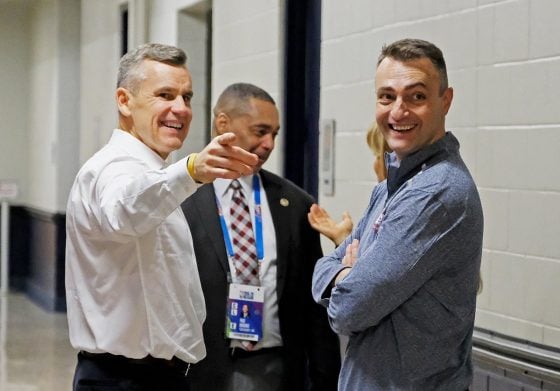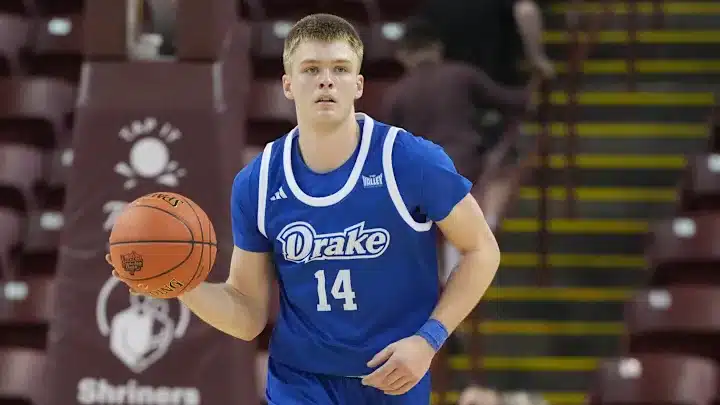BOSTON — Jaylen Brown returned to the floor for the second day of preparation for the Celtics’ return to play following the In-Season Tournament layoff. Boston took the weekend off as Brown traveled to Art Basel to discuss the intersection of art and sport, while meeting with minority groups in attendance.
On Tuesday, he spent time after shootaround, as he often does, with Tony Dobbins and four other assistant coaches. They worked methodically through different sets, reads and actions for Brown. It’s become his go-to method of simulating his role in Joe Mazzulla’s offense and advancing his oft-criticized playmaking skills. Brown entered this week’s mini series with the Cavs averaging 3.3 assists and 2.5 turnovers per game. ESPN highlighted how he had 0 assists and 43 shots between the Philadelphia and Indiana games last week on Instagram.
“Y’all corny. Watch the game,” Brown commented online last Wednesday.
“Probably a slow news day,” Brown told reporters at shootaround on Tuesday. “No context. It is what it is. Most people, they don’t watch the game. It’s all about trying to get better, improve and helping my team win, staying consistent in that regard, x, y and z. That’s what my focus is on.”
The increased scrutiny on Brown’s performance came as expected following a Game 7 meltdown against Miami where he committed eight turnovers and shot 8-for-23 with Jayson Tatum spraining his ankle on the opening play. Brown signed a five-year, $288.3 million contract to become the highest paid player in NBA history two months later. Despite an All-NBA season and steady improvement, the bitter taste that followed the loss remained for fans and detractors alike.
It’s reasonable in some sense. As an increased share of Boston’s cap, Brown’s presence will inevitably reduce the talent on the team around him, calling on him to expand his game in areas where he’s struggled to so far in his career. He’s done so in spurts to begin this year, defending better on one of the best units in the league than he did one year ago, and reducing his turnover rate from 11.4% to 10.9% — albeit with less ball time. He’s also struggled at points to stay consistently involved in an offense that’s added two stars.
Brown — always seeking to challenge norms in sports discussion — questioned over the summer why greater scrutiny gets placed on athletes when they sign larger contracts.
“I’m always getting better. It’s been the story from me from the beginning of time,” Brown said. “I’m gonna keep improving, keep getting better. I’m not the same player I was last year and I won’t be the same player a year from now. Always trying to improve and get better and work on my weaknesses, and I put in a lot of work this summer. Obviously, it was a tough loss, losing on the home floor one game before the Finals, and since then, I’ve been dedicated to making myself a better basketball player.”
Midway through his session on Tuesday, Brown set a down screen on Jermaine Bucknor, he fought through it, so Amile Jefferson screened Dobbins, attached to Brown, and freed Brown from both defenders for a pull-up three. “Yes!,” Jefferson yelled as the shot fell.
Brown entered playmaker mode on the next set, screening, rolling and pulling help from a defender before resetting to the corner to draw two and finding Jefferson behind-the-back for an open three. Then, Dobbins and Brown had a conversation, pointing to different spots on the floor.
It’s how Mazzulla, who watched part of the session and interjected at one point, utilizes Brown, more often as a screener and finisher, but empowered, at times, as a ball-handler. Brown has been adaptable in an offense that seeks to find the best matchup possible, whether for himself or others. Sometimes, for such a talented starting lineup, his job is simply to space the floor. There’s no stat for doing that correctly other than Boston’s starters boasting the best net rating.
“It’s just carryover to the game,” Brown told CLNS Media/CelticsBlog. “When you see how they guard you in different ways, your brain is familiar when you go through it, so you recognize it faster. It just helps with your decision-making and stuff like that. Going over different looks, coverages that you might get, how teams guard, everybody guards in a different way. Some people may double you, some people may go under, some people may keep a guy matched up on you. You gotta be able to adjust to make the right reads.”





